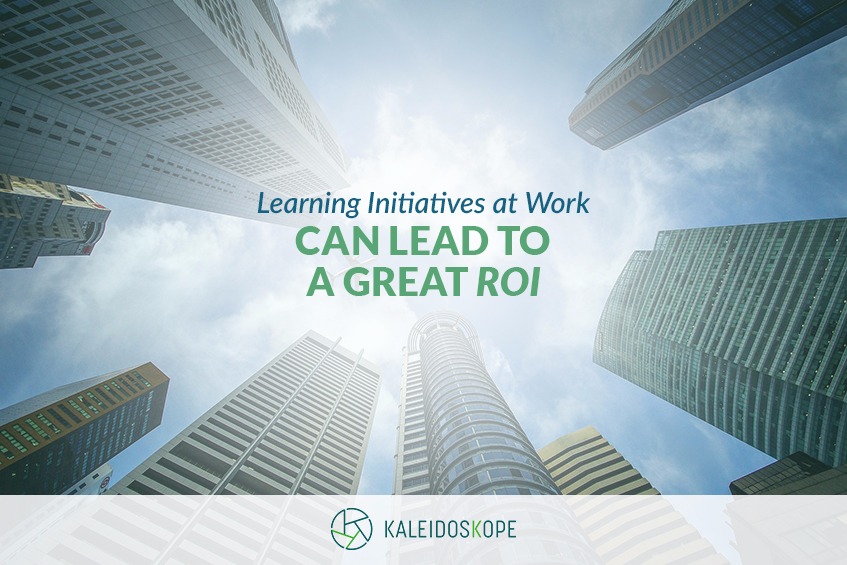Learning Initiatives at Work CAN Lead to A Great ROI. Here’s How.
“You get what you pay for,” as the saying goes, but when it comes to learning initiatives at your organisation, how do you determine the return on your investment?
While most would agree on the importance of training programmes at work, there remains the need to provide tangible and measurable results—mainly because of the resources that have to be committed. Demonstrating these results to key decision-makers ensures continued support for these initiatives and the continuing development of your staff.
Hardly anyone would dispute the difficulty of demonstrating the ROI of learning and development initiatives, but it can be done, just as a great ROI can be achieved using the right learning strategies.
Substantiating ROI is Necessary

Learning programmes must, at the outset, be regarded as a catalyst—something that drives business growth. Training is not simply “good for morale” or something that is “nice to do when the company has extra funds”. Neither is it a “chore” or something that “has to be ticked off of the company’s annual to-do list”.
If you are responsible for L&D at your organisation, it’s up to you to show executives exactly why learning is essential to maintaining your competitive edge. Technology is changing the way business is done in every industry, every day, and if your team isn’t able to keep up with these changes, you can all but expect your competitors to overtake you tomorrow.
Fail to prove this to management, and L&D becomes one of the first departments considered for downsizing or reduced funding—more so when one considers the millions of dollars that are spent annually by larger organisations on training.
Determining the ROI of learning programmes also helps you identify which methods work best for your organisation and to fine tune training processes based on objective data. More importantly, keeping tabs on the returns of your programmes helps to make sure that learning sticks, or that employees actually apply what they have learned in the workplace.
Methods for Measuring ROI

The difficulty in measuring the ROI of learning initiatives lies in how the results are not always readily observed. If a programme, for instance, is focused on teaching staff how to use certain software or equipment, or to follow a particular process, the results of this programme are easily appreciated.
But assessing the impact of initiatives such as those that involve behavioural changes, such as a higher level of engagement at work, can be a little more challenging to assess.
Traditional means of measuring the impact of learning events, where metrics include programme attendance, may not necessarily have been ROI-oriented. This means that your Key Performance Indicators should be identified before learning strategies are implemented with ROI already in mind.
Define the pre-programme standing of your team as well as the objectives they need to reach, and pre-determine how the data you need will be collected during and after the programme. Standard data gathering methods include surveys or “smile sheets”, case studies, quizzes or exams or interviews with programme participants.
Using Metrics That Matter

With measurable impact as the pole star of your learning initiatives, what you measure performance against now takes on a renewed significance. While it makes sense to measure programme results against your own organisation’s standards, evaluating them against industry-wide standards makes your L&D efforts that much more relevant and competitive.
Metrics That Matter (MTM) is a cloud-based learning analytics platform that collects data used to evaluate learning programmes. When used in tandem with a Learning Management System, MTM automatically solicits feedback from programme participants after every learning event.
Collected using text analysis, comments and suggestions from both participants and managers, this feedback generates actionable insights that can drive organisational change. MTM’s measurement tools include tests which assess knowledge gained and transferred, and feature individual as well as aggregate results.
Data is compiled and benchmarked against other organisations and industry standards in terms of training type, job type, business unit and region, and presented via dashboards and automated, on-demand reports.Benchmarking paves the way for richer conversations with internal stakeholders, such as the sponsor of the training initiative, and allows objective assessments of the results to be made.
Organisations where MTM has been integrated into learning initiatives have reported improved productivity, lower administrative costs and reduced wasted learning. Users have also reported returns of at least 20% on their investment while adopting learning best practices.
MTM and the HPLJ
Unlike one-off or one-time learning events, a High Performance Learning Journey (HPLJ) is an ongoing process that involves gaining, building up and applying knowledge, and strengthening the results of the learning programmes. Assessing the knowledge acquisition and application process, and measuring programme results is where MTM comes in.
In addition to using the HPLJ approach in its learning programmes, Kaleidoskope works with MTM as its learning analytics partner to track the progress made by programme participants. MTM provides insight on how well employees learn and practise new skills, and to identify areas for improvement that may be focused on in future learning initiatives.
By making sure that employees are applying what they have learned and improving their performance in the workplace, a HPLJ supported by MTM assesses the impact of the interventions and makes it easy to demonstrate these returns for the benefit of stakeholders and management.
To get started on an HPLJ partnered with MTM at your organisation, talk to us at Kaleidoskope, today.
Leadership Training
- Business Storytelling – A Critical Skill For Great Leadership
- Want to make history as a leader? Try studying these great leaders from history
- Solution Focused Leadership Coaching
- Leading the Way for Leaders: How Your Leadership Can Continue to Evolve
- How to Manage a High-Performance Team Made Up of Different Personalities
- Have You Mastered the 4 Leadership Fundamentals?
- Do You Practise Adaptive Leadership? Your Organisation Needs You To
- Why A Good Leader Needs To Understand Business Agility
- 20 Qualities of a Good Leader in Times of Change (A Checklist)
Corporate Training
- Why is your training, boring?
- Learning Initiatives at Work CAN Lead to A Great ROI. Here’s How
- Corporate Training Doesn’t Seem to Be Working? You Need an HPLJ Approach!
Facilitation Training
- Facilitate a High Impact Training Course with Accelerated Learning
- Accelerative Learning – A Better Return on Training Investment (Part 1)
- Accelerative Learning – A Better Return on Training Investment (Part 2)
- Accelerative Learning – A Better Return on Training Investment (Part 3)
Virtual Learning
Start Your High-Performance Learning Journey
WITH KALEIDOSKOPE NOW!
Find out why a High Performance Learning Journey helps companies to become more efficient with their corporate training.
Corporate Training Doesn’t Seem to Be Working? You Need an HPLJ Approach!

If business is a game, it’s natural to want to be on a winning team. Winning teams are made up of high-performing players, and if the players have yet to reach optimal status, it makes sense for businesses to invest in their corporate training and development–to which all of Kaleidoskope’s past attendees in Singapore attests.
But just how effective is corporate training, anyway? Not very, as research numbers seem to suggest: Only about 20% of training results in improved job performance for managers and leaders. A study conducted by the Harvard Business Review says that only one in four of the senior managers covered by the study reported that training made critical contributions to business outcomes.
This is in spite of the USD 356 billion dollars spent by companies around the world on efforts to help their teams unlock their star-player potential. One can’t help but think that the USD 13.5 million lost by businesses per year for every 1,000 employees they train might have been better spent on more productive ventures.
Understanding Why and What Must Be Done
If you are in charge of learning and development or manage a team at your organisation, you don’t need statistics to tell you that something needs to change in the way your team gears up for the Great Game. How often have you invested time and resources into learning events or initiatives, only to have them remember very little of what they have learned upon their return?
It’s frustrating, to say the least, to see all of your hard work and hard-earned funds yield little, if any, positive change. Understanding why traditional learning programmes fail to deliver, and what can be done instead, are the first steps to be taken towards planning and implementing corporate training programmes that really work.
There is a myriad of reasons for training initiatives falling short of managerial expectations. Among these could be a deep-seated corporate culture that does not support training, or simply that people, having done things in a certain way for so long, find it nearly impossible to change their ways. Another might be the failure on the part of management to execute planned organisational changes that would have made staff changes on an individual level, possible—which is one compelling reason why strengthening your leaders is so important.
Other reasons include employees having a negative attitude towards training events, which means they might feel forced to attend, regard the event as a vacation, or see it as a venue for expressing pent-up emotions towards work in general.
But arguably one of the most noteworthy reasons is how most companies are unable to measure the returns on investment made into learning programmes in the first place. This, in turn, reveals a lack of planning in terms of the programme’s objectives and structure as well as measures for tracking participant progress.
The High Performance Learning Journey
This is why your organisation needs to embark on a High Performance Learning Journey or HPLJ. By approaching learning initiatives as an ongoing process or journey, as opposed to a one-time, annual cram session, businesses can ensure that their investment is not wasted and delivered a measurable impact from their L&D programmes.
Developed by learning effectiveness expert, Dr. Robert O. Brinkerhoff, the HPLJ approach prepares participants in a learning programme by identifying and addressing potential issues and points of concern even before the journey begins. This helps to minimise any obstacles to learning ensuring a smooth learning process.
As the HPLJ progresses, participants are encouraged to commit to the journey by helping them to define what the return on the investment into their training will be for themselves and for the organisation. Employees recognise the benefits of applying what they have learned, and receive support especially during those times when the initial excitement that accompanies a new learning initiative tends to wane.
Team members also build up their knowledge foundation which, during an HPLJ, they had already begun to establish prior to key learning events. This enables them to get off to a quick start in practising newly acquired skills, which they can hone further as the journey continues.
Through practice of their newly acquired skills, they can further develop their confidence in applying concepts and techniques that might contradict their old workplace routines. The HPLJ uses a “crawl, walk, run” strategy that allows staff to move from trying out their new skills in role-playing scenarios, to practising with real-life colleagues, to actual applications in the workplace.
As the results of the HPLJ being more concrete, participants focus on strengthening these results through the use of tools and gaining a clear direction of where the journey will continue to take them. This helps to make sure that they continue to use the skills they have learned even outside of the formal learning programme, and seek opportunities for improvement. These opportunities include further research and “paying the learning forward” by training others.
Automating the Learning Journey
It has become inevitable for technology to play key role in an organisation’s HPLJ, and Learning Transfer Platforms or LTPs have proven to be a real game-changer in today’s learning initiatives. These platforms use cloud-based software to customise the learning journey to each participant by integrating personalised engagement with the learning events.
An LTP works by embedding the entire HPLJ into its platform, enabling trainers and managers to digitally manage and track the journey from start to finish. The LTP especially makes it possible for managers to interact with staff and to create a learning community where everyone involved can support and encourage one another during the learning process.
Accomplishing training tasks and assignments become easier with an LTP, as participants are given the flexibility to manage their own schedules particularly when learning is done alongside real-world work in real time. Team members become more likely to engage and apply the knowledge they have gained, and become accountable for their personal progress.
Using LTPs have been shown to significantly improve the impact of investments made into learning programmes, as behavioural change has been demonstrated at improved rates with greater consistency among a greater number of participants.
As they are more cost-efficient compared to other learning programme interventions, the platforms also greatly facilitate scaling the learning journey as needed to a larger number of participants across organisational settings and language capabilities.
As Singapore’s only learning programme provider that has been certified in Dr. Brinkerhoff’s HPLJ Approach, Kaleidoskope has successfully guided the teams of several organisations across various industries on their own learning journeys. Get in touch with us to get started on your own learning journey, today.
Leadership Training
- Business Storytelling – A Critical Skill For Great Leadership
- Want to make history as a leader? Try studying these great leaders from history
- Solution Focused Leadership Coaching
- Leading the Way for Leaders: How Your Leadership Can Continue to Evolve
- How to Manage a High-Performance Team Made Up of Different Personalities
- Have You Mastered the 4 Leadership Fundamentals?
- Do You Practise Adaptive Leadership? Your Organisation Needs You To
- Why A Good Leader Needs To Understand Business Agility
- 20 Qualities of a Good Leader in Times of Change (A Checklist)
Corporate Training
- Why is your training, boring?
- Learning Initiatives at Work CAN Lead to A Great ROI. Here’s How
- Corporate Training Doesn’t Seem to Be Working? You Need an HPLJ Approach!
Facilitation Training
- Facilitate a High Impact Training Course with Accelerated Learning
- Accelerative Learning – A Better Return on Training Investment (Part 1)
- Accelerative Learning – A Better Return on Training Investment (Part 2)
- Accelerative Learning – A Better Return on Training Investment (Part 3)
Virtual Learning
Start Your High-Performance Learning Journey
WITH KALEIDOSKOPE NOW!
Start Your High-Performance Learning Journey
with Kaleidoskope NOW!
Call Us Or Message Us on Whatsapp
Or Fill Out the Form Below



